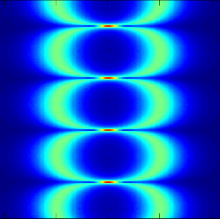Synopsis
Optical communication systems are the backbone of today's wordwide communication infrastructure. Fiber optical links connect data centers, cities and continents; free-space optical links connect satellites and space vehicles with earth-bound basestations. This course introduces physical layer technologies and modulation as well as detection schemes to communicate across different optical media.
Contents and Educational Objectives
Lecture 1: Historical Notes, Geometrical Optics and Multi-Mode Fibers
1.1. Historical Notes –MetallicWaveguides as Competitor
1.2. Optical Access and Transport Network
1.3. Frequency Band of Optical Communications
1.4. Structure of Optical Fibers
1.5. Basics of Geometrical Optics
1.6. Light-ray Propagation in a Step-index Fiber
1.7. Modal Dispersion
Graded-index Fiber
1.A. Appendix
Spatial Multiplex with Multi-Mode Fibers (MMF)
Spatial Multiplex with Multicore Fibers (MCF)
Lecture 2: Single-Mode Fibers and Nonlinear Schrödinger Equation
2.1. From Multi-Mode to Single Mode
2.2. Wave Propagation in an Optical Fiber
Field Envelope of Fiber Cross-Section – The “Spot”
Wave Propagation along the Fiber Axis
2.3. Wavelength and Intensity Dependency of Refractive Index
Wavelength Dependency, Intensity Dependency
Impact of Wavelength and Intensity Dependency on Wave Equation
Final Steps to the Nonlinear Schrödinger Equation
2.4. Nonlinear Schrödinger Equation
Lecture 3: Chromatic Dispersion
3.1. Transfer Function of the Fiber (Chromatic Dispersion only)
3.2. Propagation Delays and PulseWidening
Difference of Group Delays, Definition of the Dispersion Coefficient and its Slope
Pulse Widening, Accumulated Dispersion and Dispersion Tolerance
3.A. Appendix
Group Velocity Dispersion
Lecture 4: Link Budget: Amplification and Dispersion
4.1. Attenuation
4.2. Optical Amplifiers
4.3. Submarine Cables
4.4. Erbium-Doped Fiber Amplifier (EDFA)
4.5. Considering a Single Amplifier
4.6. Considering a Cascade of Amplifiers
4.7. Signal-to-Noise Ratio at Fiber Input/Output
4.8. Power and Dispersion Budget
4.A. Appendix
Why Passive Optical Elements have a Noise Figure
Why an Amplifier at the End of Cascade has Negligible Influence on Noise Figure
Notes on Raman-Amplification, Properties of Optical Sources (Transmitter)
Properties of Optical Detectors (Receiver)
Lecture 5: Kerr-Effect: Nonlinear Fiber Channel
5.1. Kerr-Nonlinearity
Revisiting the Influence of Chromatic Dispersion, Influence of the Kerr-Nonlinearity
5.2. Soliton Propagation
Special properties of soliton impulses
5.3. Simulation by Split-Step-FourierMethod (SSFM)
5.4. Non-ideal Soliton Propagation
5.5. Nonlinearities and Noise
5.A. Appendix
Higher-order Solitons
Lecture 6: Free-Space Optical Channel
6.1. Basics of the Free-Space Optical Channel
6.2. Transmit Laser Beam-Shapes
Gaussian Beam, Bessel Beam
6.3. Simple Link Budget Considerations
6.4. Modeling Atmospheric Turbulence and Scintillation
Model for Refractive Index Fluctuation, Simulation using the Split-Step Fourier Method
6.5. Some Applications
6.6. Comparison to RF
6.A. Appendix
Refractive Index Fluctuations as Random Process
Lecture 7: Optical Intensity-based Communication
7.1. Preliminaries – Revisiting Fiber Impairments
7.2. Block Diagram of End-to-End Link
7.3. ExternalModulation with Mach-Zehnder Modulator
Block diagram of MZM, Splitter/Coupler, Transfer characteristic
Push-Pull mode (amplitude modulation, AM)
7.4. Pulse Shaping
Non-Return-to-Zero (NRZ), Return-to-Zero (RZ), Spectral Properties
7.5. Eye diagram
7.A. Appendix
Modulation Index and Excess Loss, Push-Push mode (phase modulation, PM)
Extinction ratio, Classic Nyquist Raised Cosine Pulse Shaping
Lecture 8: Duobinary and Differential Modulation
8.1. Duobinary Modulation
Transmitter Spectral Properties, Precoding and Symbol Detection, Eye Diagram
8.2. Differential Modulation with DBPSK
Block Diagram of End-to-End Link, Symbol Detection, Extension to DQPSK
8.A. Appendix
Differential Modulation with DQPSK
Lecture 9: Optical Coherent Communication
9.1. Block Diagram of End-to-End Link
9.2. Modulation
A Short Primer on Digital QAM, Optical I/Q Modulation
Linearization by Digital Predistortion
9.3. Demodulation
Coherent Detection using Local Oscillator, Two-by-Four 90-degree Hybrid
Constellation Diagram after Chromatic Dispersion
9.4. Performance in the Spectral Efficiency and BER Chart
9.A. Appendix
Square-Law Detection (without RX Carrier)
Lecture 10: Polarization and Wavelength Multiplex
10.1. NLSE and Manakov equation
10.2. Polarization Multiplex
Signals at the Transmitter, Simplified Two-Dimensional (Linear) Channel Model
Signals at the Receiver, Polarization Phase and IQ-Phase
10.3. Wavelength Division Multiplex
Lecture 11: Carrier Frequency Offset Contents
11.1. Overview of DSP for Coherent Detection
11.2. The Frequency Offset Challenge
11.3. Estimation and Compensation
Blind Estimation using the M-th Power Method, Carrier Frequency and Carrier Phase Compensation
Limitations of the M-th Power Method, Extending the Range of the M-th Power Algorithm
Lecture 12: Chromatic Dispersion Compensation by Digital Equalization
12.1. Revisiting the Effects of CD in Time and Frequency Domain
12.2. Design of FIR Filters for CD Compensation
FIR Filter Basics, Obtaining Filter Taps by Truncation
Determining the Maximal Number of Filter Taps
Obtaining Filter Taps by Least Squares Optimization
Lecture 13: Equalization-Enhanced Phase Noise
13.1. Laser Phase Noise
Phase Noise Measurement
13.2. Equalization-Enhanced Phase Noise
13.3. Effect of EEPN on QAM Constellations
13.4. Mitigation of EEPN
Using Timing Recovery
Lecture 14: Application Example -- Passive Optical Networks (PONs)
14.1 History and Overview
14.2 Technology
Note: Course contents subject to change in order to keep up-to-date with latest research results and developments in the communications industry.
Timeline
-
Guiding of light by refraction 1840sFirst demonstration of the principle that makes fiber optics possible (Colladon and Babinet).
-
Photophone1880Very early precusor to fiber-optic communications, Bell's Volta Laboratory, Washington, D.C.
-
Information Theory 1948Claude E. Shannon's classic paper "A Mathematical Theory of Communication" in the Bell System Technical Journal.
-
First fiber-optical transmission system 1965First demonstration of an optical system by Manfred Börner/Telefunken Research Labs Ulm.
-
Corning breakthrough 1970A group of researchers at Corning Inc. produce single-mode fiber from pure silica with an attenuation of 20 dB/km.
-
Wavelength-division multiplexing (WDM) 1978Publication of concept, first realizations in laboratory 1980.
Course Information
6 ECTS credits. Course given in English language.
Lectures
| Lecturer | Prof. Dr.-Ing. Stephan ten Brink |
| Time Slot | Wednesday, 11:30-13:00 |
| Lecture Hall | V47/02/2.314 (ETI2) |
| Weekly Credit Hours | 2 |
Exercises
| Lecturer | Sebastian Jung, Tim Janz |
| Time Slot | Tuesday, 8:00-9:30 |
| Lecture Hall | V47/02/2.314 (ETI2) |
| Weekly Credit Hours | 2 |

Stephan ten Brink
Prof. Dr.-Ing.Director


